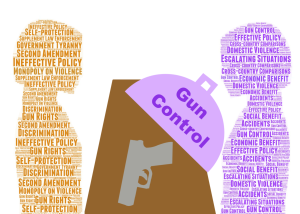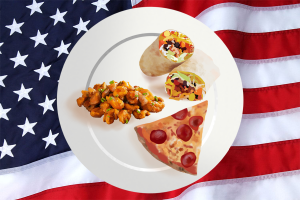Con (less gun control):
April 21, 2021
It is difficult to debate gun laws without touching on the Second Amendment of the U.S. Constitution, which states that: “A well regulated Militia, being necessary to the security of a free State, the right of the people to keep and bear Arms, shall not be infringed.”
This amendment is a protection of the private right of individuals to keep and bear arms. Though some may argue the beginning section of the amendment acts as a constraint that only allows citizens to keep and bear arms in connection to militia organizations like the National Guard, it can actually be interpreted as supplying one of many reasons to guarantee citizens the right to keep and bear arms.
The Second Amendment comes from a revered document in American history, and the private right of individuals to keep and bear arms is a part of America’s sacred democratic tradition which the Constitution represents.
The Second Amendment was born out of peoples’ fear of an all-powerful government using military force to oppress civilians. The idea of the government only using militias composed of regular citizens, however, gradually appeared unrealistic, and the federal government received the power to maintain standing armies.
While the Federalists and Anti-Federalists soon engaged in heated debate over the extent of military power the federal government should wield, they were relatively in agreement that the federal government had no power to disarm citizens. The right of people to keep and bear arms was as obvious as their right to freedom of speech and religion, and continues to be important today. The right guaranteed by the Second Amendment plays a key symbolic role in protecting civilians from potential government tyranny that might strip them of crucial rights like freedom of speech.
Some distrust of the government is rooted in the tradition of American democracy. In this day and age, any insurrection attempts will likely be unsuccessful, especially after huge advances in military technology which give the government far more firepower than any civilian gun owner. Gun ownership, however, remains a primary way for ordinary citizens to retain some power and express their reservations about the American government.
“That is part of the great divide in the country today: do you trust the government?” said Government and Politics teacher David Pugh. “What should the role of government be? Is it the government’s job to solve the major problems facing society or, as President Ronald Reagan said, ‘The government is not the solution to our problem. The government is the problem.’ Your attitude toward government has a lot to do with this issue.”
A facet of excessive government power is complete control over physical violence, which gun ownership can counter. A defining characteristic of the modern state is a “state monopoly on violence,” the idea that the state uses political organization and domination, including violence, to establish the legitimacy of its rule. The state is not the only actor of violence, or user of it, but only the state has power to authorize violence. The state’s monopoly on violence can be challenged by political insurgents. Some believe that the monopoly includes not only power of authorization, but also legitimate usage, and thus the monopoly can also be challenged by cases of individual self-defense, which gun ownership promotes.
The right to possess guns is tied to the rights of self-defense. Although people debate if the use of guns is a truly effective self-protection method or not, guns offer a sense of security to many individuals. Even if guns are not used directly in confrontation, some believe gun ownership can deter crime. Owning a gun can also be seen as an act of initiative, in protecting one’s own life and those of others. Thus guns can be viewed as a solution to violent crime, and gun ownership and usage in some cases as a fulfillment of civic duty.
The public is most familiar with a certain image of gun culture in America: men from more rural regions who value self-reliance and independence, and try to maintain their masculinity and social relevance in a changing nation. In reality, gun owners can look very different, and use guns for various reasons.
Through extensive interviews with gun-carriers and pro-gun advocates in Michigan, an analysis found that guns appeal to gun-carriers from many different backgrounds in the face of both real and perceived socio-economic insecurities. Women who carried guns tended to see it as an empowerment. People of color often saw guns as a supplement or substitute to a public law enforcement that they believed, and often had, failed to serve them. Doubt of the ability of public law enforcement to police effectively justified gun ownership and use. Gun ownership can be a means of helping maintain social order and asserting political rights.
In the past, several gun control laws have systematically targeted minorities and marginalized groups, and this history should be a lens to consider gun control laws today.
From the 17th century onward, suppressing slaves and African Americans compelled many states to pass gun control legislation. Fearing slave insurrections, southern states restricted gun ownership for African Americans. Even after the 13th, 14th, and 15th amendments were passed, black codes continued to restrict gun ownership for mainly blacks, and later, after measures were taken against black codes, local law enforcement continued to discriminate against African Americans, with white retailers alerting local sheriffs if African Americans bought a gun, leading to arrests and weapon confiscation.
In the North, gun control was similarly enacted, as it seemed, to control a group of individuals, mostly Eastern and Southern European immigrants, rather than the distribution of guns. Legislation banning “aliens” from owning firearms received support from groups like the Immigration Restriction League, which were often founded and supported by factory owners and capitalists who could profit from an unarmed workforce finding it difficult to unionize against strikebreakers with weapons.
One striking example of a suppressed minority group was the Black Panther Party (BPP), a militant and revolutionary group that used strategies differing from mainstream nonviolent protest during the 1960s civil rights movement. The group emphasized the importance of self-reliance in African American communities, and demanded ten points, including equal access to education and the end of police brutality. The central focus of BPP was their armed community patrols which monitored police activity in an attempt to reduce police harassment in black communities. Not long after the formation of the BPP, lawmakers viewed the group as a threat and the Mulford Act, linked to obstructing the group, was passed in 1967 prohibiting citizens to openly carry loaded firearms in public spaces.
Current gun control laws may not be overtly discriminatory, but the laws themselves differ from how they are systematically put in practice and enforced. Stricter gun control laws would cause over policing of low-income and minority communities, which would not be positive nor effective. In 2018, approximately 56% of firearm offenders were black, while 22% were Hispanic and 19.6% were white. Gun control laws would disproportionately affect black communities.
Considering the hike in protests against police brutality in the past few years, and many calls for completely replacing the police in several black communities, an increase in policing and common tactics of enforcing gun control measures like stop-and-frisk would only heighten tensions. Until the relationship between these communities and police law enforcement is gradually improved, and more investments are made in areas like education and healthcare to alleviate poverty in these communities, tightening gun control would bear down on vulnerable groups.
Many gun control laws may not even be effective. RAND Corporation, a nonpartisan research organization that develops solutions to public policy challenges, published an analysis reviewing many different studies on gun laws, and drawing conclusions on the effect of 18 types of gun policies on eight kinds of gun violence, including mass shootings and suicide.
There is some evidence for noticeable effects, such as background checks lowering homicide, and stand-your-ground-laws — which permit individuals to use deadly force in violent confrontations — increasing homicide. However, of the 144 policy effects RAND examined, most were inconclusive.
Approximately 61 percent of deaths from firearms are suicides, which are considered a form of gun violence. This violence carried out with guns could be conducted with other weapons, and points to the need for better mental health support rather than the need for more gun control laws. Additionally, an estimated 80 percent of gun violence crimes have involved unlawful possession of the weapon, indicating that gun control laws would create minimal impact on gun violence crimes. Perpetrators of gun crime, already disobedient of laws, would be likely to obtain guns in spite of policies meant to obstruct them, and, again, violence carried out with guns could be conducted with other weapons.
“I think some policies in general will not stop firearm related shooting,” said junior Kevin Li. “In order to commit to such a crime, you’re already ignoring what is set in stone by law. I don’t think there is any good way to completely prevent shootings. However, what we could do is educate the citizens on how to safely and effectively use self defense measures. That doesn’t mean only guns.”
The availability of guns does not necessarily affect rates of gun violence. Some form of restrictions, like background checks, can help to some extent in placing guns in the right hands. However, for many individuals, the benefits of most gun control policies do not outweigh the costs that would be imposed on individual rights.



























































